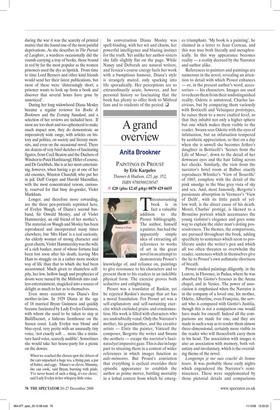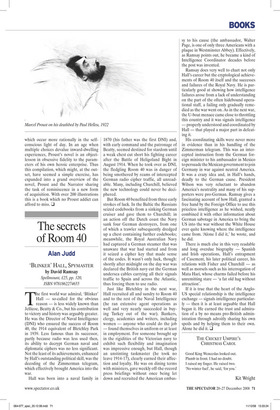A grand overview
Anita Brookner
PAINTINGS IN PROUST by Eric Karpeles Thames & Hudson, £25, pp. 352, ISBN 9780500238547 ✆ £20 (plus £2.45 p&p) 0870 429 6655 This unassuming book is in fact a valuable addition to the Proust bibliography. The author, himself a painter, has had the apparently simple idea of extracting all references to works of art in the great novel in an attempt to demonstrate Proust’s knowledge of, and reliance on, paintings to give resonance to his characters and to present them to his readers in an indelible physical form. The exercise proves both seductive and enlightening.
Proust was a translator of Ruskin, yet he rejected Ruskin’s message that art has a moral foundation. For Proust art was a self-explanatory and self-sustaining exercise which excluded praise and condemnation. His work is filled with characters who are undoubtedly venal. Only the Narrator’s mother, his grandmother, and the creative artists — Elstir the painter, Vinteuil the composer, Bergotte the writer and Swann the aesthete — escape the narrator’s fascinated yet impassive gaze. This is due in large part to situating them in a context of wider references in which images function as aide-mémoires. But Proust’s conviction that everything is cyclical overrides their episodic appearance to establish the author as prime mover, battling mortality in a lethal contest from which he emerg es triumphant. ‘My book is a painting’, he claimed in a letter to Jean Cocteau, and this was true both literally and metaphorically. In this way appearance becomes reality — a reality decreed by the Narrator and author alike.
References to painters and paintings are numerous in the novel, revealing an attention to detail with which Proust enhances — or, in the present author’s word, accessorises — his characters. Images are used to redeem them from their undistinguished reality. Odette is untutored, Charlus lascivious, but by comparing them variously with Botticelli and Velazquez prototypes, he raises them to a more exalted level, so that they inhabit not only a higher sphere but one which makes them visible to the reader. Swann sees Odette with the eyes of infatuation, but an infatuation tempered by aesthetic appreciation, so that on a day when she is unwell she becomes Jethro’s daughter in Botticelli’s ‘Scenes from the Life of Moses’, down to the detail of her downcast eyes and the hair falling across her cheeks. Similarly, the view from the narrator’s hotel room at Balbec exactly reproduces Whistler’s ‘View of Trouville’ of 1865, complete with the detail of the pink smudge in the blue grey vista of sky and sea. And, most famously, Bergotte’s passionate absorption in Vermeer’s ‘View of Delft’, with its little patch of yellow wall, is the direct cause of his death. Morel, Charlus’ protégé, is likened to a Bronzino portrait which accentuates the young violinist’s elegance and goes some way to explain the older man’s doting possessiveness. The themes, the comparisons, are pursued throughout the book, adding specificity to sentences which seem to proliferate under the writer’s pen and which all too often threaten to overwhelm the reader, sentences which in themselves give the lie to Proust’s own asthmatic shortness of breath.
Proust studied paintings diligently, in the Louvre, in Florence, in Padua, where he was absorbed by Giotto’s frescoes in the Arena chapel, and in Venice. The power of association is emphasised when the Narrator is in the company of a loved one, his mother, Odette, Albertine, even Françoise, the servant who is compared with Giotto’s Justitia, though this is not a comparison one would have made for oneself. Indeed all the comparisons are made for one, and they are made in such a way as to render them almost three-dimensional, certainly more visible to the reader who will thenceforth carry them in his head. The association with images is also an association with memory, both voluntary and involuntary, which is the overriding theme of the novel.
Longtemps je me suis couché de bonne heure. It was probably those early nights which engendered the Narrator’s reminiscences. These were supplemented by those pictorial details and comparisons which occur more rationally in the selfconscious light of day. In an age when multiple choices devalue inward-dwelling experiences, Proust’s novel is an objectlesson in obsessive fidelity to the parameters of his own heroic enterprise. Thus this compilation, which might, at the outset, have seemed a simple exercise, has expanded into a grand overview of the novel, Proust and the Narrator sharing the task of reminiscence in a new form of acquisition. With over 200 illustrations this is a book which no Proust addict can afford to miss. ❑























































































































 Previous page
Previous page